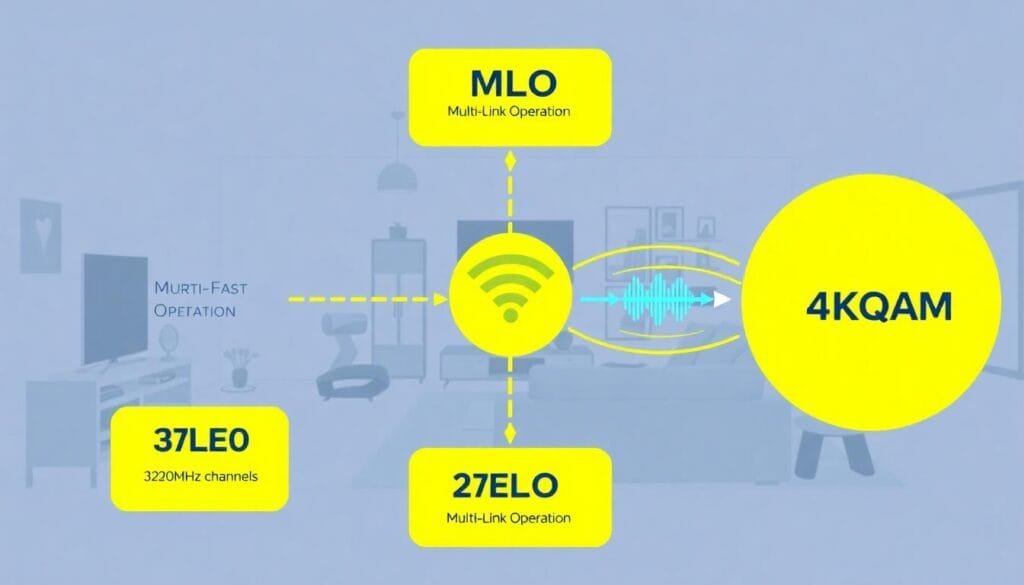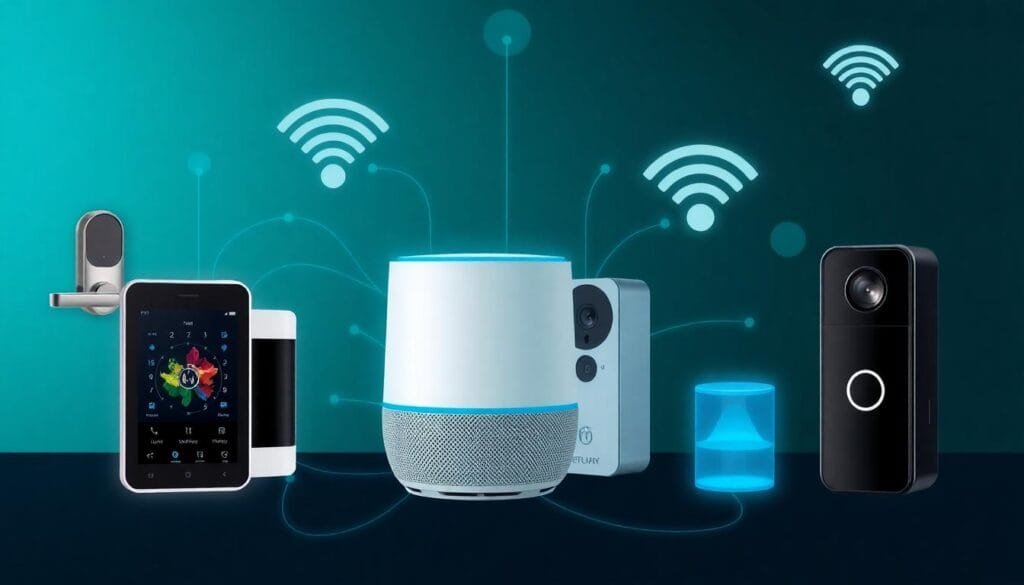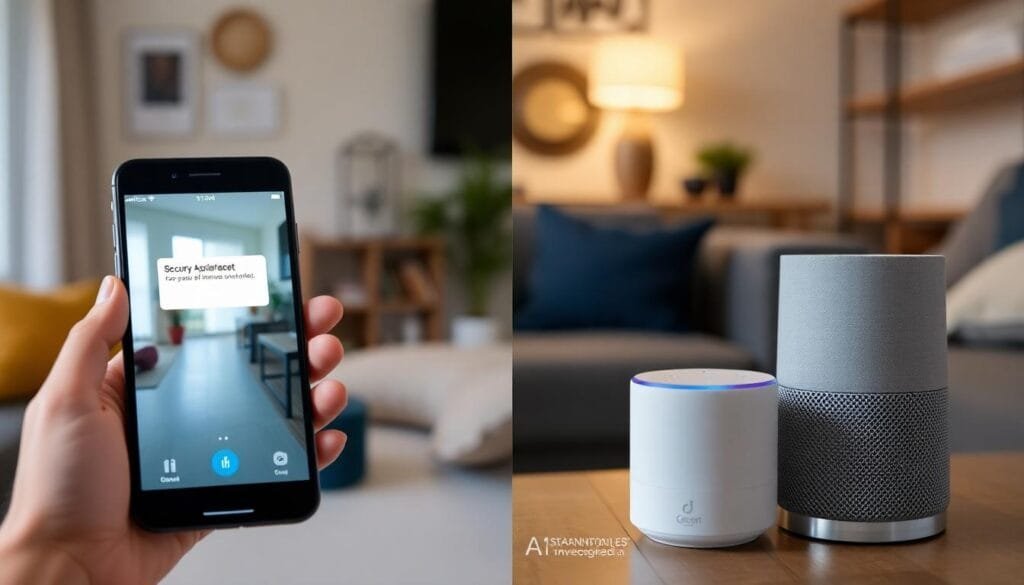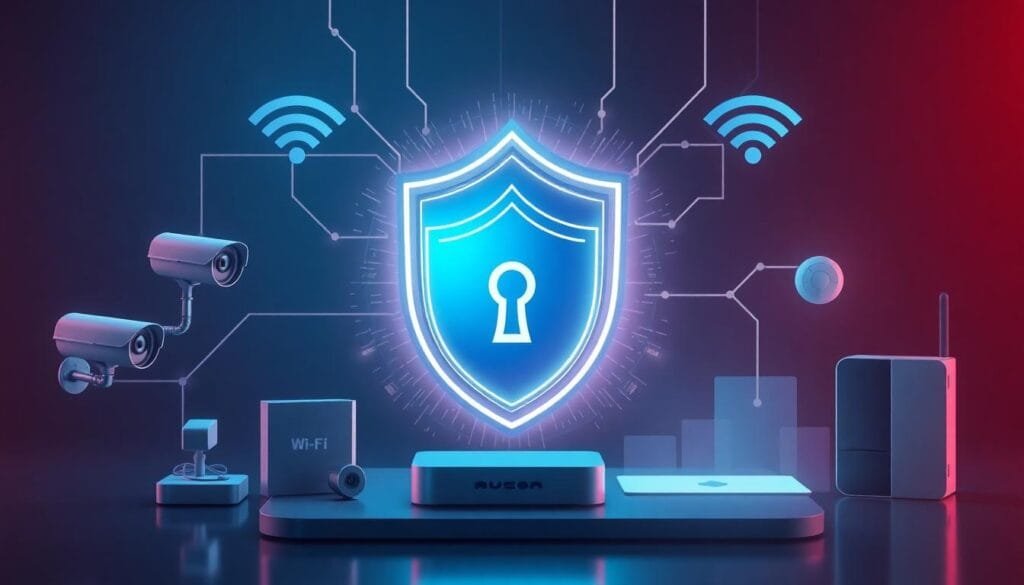Ever had your video doorbell freeze right when someone’s at your door? Or waited what feels like forever for your smart speaker to respond to a simple command? These aren’t random glitches—they’re symptoms of how current Wi-Fi standards struggle with our increasingly connected homes. Understanding how Wi-Fi 7 affects smart home systems is crucial if you want to solve these everyday frustrations and unlock the true potential of your connected devices.
When we look at how Wi-Fi 7 affects smart home systems, we’re not just talking about faster downloads. This new standard fixes the underlying problems that have made our smart homes sometimes feel… not so smart.
The Technical Foundation of Wi-Fi 7

To understand how Wi-Fi 7 affects smart home systems, we need to look at what’s actually changing under the hood. These aren’t just fancy specs—they solve real problems that limit our current smart home setups.
Multiple Connection Paths Instead of Traffic Jams
The biggest improvement in how Wi-Fi 7 affects smart home systems is Multi-Link Operation (MLO). Today, your devices fight for attention on a single frequency band, creating bottlenecks as your device count grows.
MLO lets devices use multiple frequency bands (2.4 GHz, 5 GHz, and 6 GHz) at the same time. It’s like having several roads instead of one—your security cameras, speakers, and TV can all communicate without getting in each other’s way.
Testing shows this can cut lag by up to 75% in homes with lots of devices, making a huge difference in how Wi-Fi 7 affects smart home systems. Learn more about MLO on TP-Link’s blog.
Wider Data Channels
Wi-Fi 7 doubles channel width from 160 MHz to 320 MHz. Think of it as widening a highway from four lanes to eight—more data can flow at once.
This matters because smart homes need more bandwidth than ever. When your security system runs multiple cameras while someone streams a movie and your appliances communicate in the background, that extra capacity prevents slowdowns.
Testing from Intel shows these wider channels support speeds up to 46 Gbps—almost 5 times faster than what Wi-Fi 6 can do. This speed boost is a key part of how Wi-Fi 7 affects smart home systems. See Intel’s official page for more details.
More Efficient Data Packing
Wi-Fi 7 uses a technique called 4K-QAM that fits 20% more information into each transmission compared to Wi-Fi 6.
For your smart home, this means faster responses. Your motion sensors, video doorbell, and voice assistants all work more quickly because they can send and receive more information in less time. Learn how 4K-QAM works on ASUS Edge Up.
Real Benefits for Your Smart Home

These technical improvements translate to practical benefits that solve common frustrations and open new possibilities.
Devices That Actually Work Together
Most homes now have over 25 connected devices, a number that keeps growing. Previous Wi-Fi standards weren’t designed for this.
A significant aspect of how Wi-Fi 7 affects smart home systems is solving the “too many devices” problem. Your lights, locks, thermostats, cameras, and entertainment systems can all function without making everything else slow down.
This is especially helpful when multiple people are home using different systems simultaneously. No more “can you stop streaming so I can check the security camera?” Check out Netgear’s overview of Wi-Fi 7 benefits.
Nearly Instant Responses

One of the most noticeable ways Wi-Fi 7 affects smart home systems is by almost eliminating lag. When you press a button in an app or give a voice command, the response comes almost immediately.
This makes a real difference for:
- Voice assistants that answer right away
- Security alerts that arrive when they’re happening, not seconds later
- Smart displays that show information the moment you ask
- Automations that trigger different devices in the right sequence
Testing shows response times under 5 milliseconds—so fast you won’t notice any delay. See how Wi-Fi 7 enhances IoT environments on CNET.
Stronger Protection Against Hackers

Security concerns stop many people from fully adopting smart home technology. An important part of how Wi-Fi 7 affects smart home systems is its improved security through enhanced WPA3 protocols.
This provides:
- Stronger encryption that better protects your data
- Improved methods to verify device identity
- Better resistance to password-cracking attempts
- Protection against unauthorized monitoring
These security features matter most for sensitive devices like door locks, security cameras, and systems that handle personal information. According to Cisco, these improvements help future-proof smart homes against emerging vulnerabilities.
What This Means for Upgrading
While the benefits are clear, there are practical things to consider before jumping in.
What You’ll Need to Change
To experience how Wi-Fi 7 affects smart home systems, you’ll need:
- A Wi-Fi 7 router (currently $300-600)
- Eventually, smart home devices that support Wi-Fi 7
- Possibly adjustments to router placement
- Potentially a faster internet plan for the increased speeds
The good news is you don’t need to replace everything at once. Wi-Fi 7 works with older devices, so you can upgrade gradually, starting with the router. According to Forbes, infrastructure upgrades are one of the key considerations holding back broader consumer adoption.
When You Can Actually Get It
Wi-Fi 7 was officially certified in January 2024, and the first routers are already available. However, compatible smart home devices are still limited.
Expect this rollout pattern:
- 2024: Initial routers and a few premium smart devices
- 2025: More mainstream devices supporting the standard
- 2026-2027: Widespread availability across most products
Most homes will run mixed environments with both Wi-Fi 7 and older devices during this transition period. As Cisco notes, full ecosystem compatibility will only mature as device manufacturers fully integrate this standard.
Future Possibilities
Beyond fixing current problems, understanding how Wi-Fi 7 affects smart home systems includes looking at what new experiences it enables.
New Types of Smart Home Interactions
The improved performance makes possible:
- Augmented reality interfaces that show information about devices when you look at them
- Virtual reality experiences throughout your home without connectivity problems
- Spatial computing applications that understand and interact with your physical space
Wi-Fi 7 also enables more complex automation scenarios that weren’t reliable before. Check out IoT For All for more on how Wi-Fi 7 will support these applications.
More Local Processing, Less Cloud Dependence
An often overlooked aspect of how Wi-Fi 7 affects smart home systems is its support for processing data locally instead of sending everything to the cloud:
- Better privacy since more data stays in your home
- Systems that keep working during internet outages
- Less dependence on subscription services
- Even faster responses by eliminating trips to external servers
These capabilities allow your smart home to learn your preferences without sharing sensitive data with outside companies. Learn more from Forbes about how Wi-Fi 7 improves local data processing.
Making Smart Homes Actually Smart
When we examine how Wi-Fi 7 affects smart home systems, we see it addresses the core technical limitations that have prevented connected homes from living up to their potential. The improvements in speed, reliability, device support, and security remove the barriers that have made smart homes sometimes feel disconnected.
For current smart home users, upgrading offers a path to eliminate the frustrations of device conflicts and unpredictable performance. For those just starting with smart home technology, it provides a more reliable foundation.
While the upgrade requires some investment and patience as compatible devices become available, the improvements in everyday usability make a compelling case for eventually transitioning to this new standard.
Have you noticed your smart home devices competing for bandwidth? Which part of how Wi-Fi 7 affects smart home systems do you think will make the biggest difference in your daily experience? Are you planning to upgrade when more compatible devices become available?
FAQ’s:
❓ How much faster is Wi-Fi 7 compared to Wi-Fi 6? (Click to Expand) ▶ Wi-Fi 7 reaches theoretical maximum speeds of 46 Gbps, about 4.8 times faster than Wi-Fi 6’s 9.6 Gbps. In real homes, expect 2-3 times the actual speed depending on your setup.
❓ Do I need to replace all my smart home devices to benefit from Wi-Fi 7? ▶ No, you don’t need to replace everything at once. Wi-Fi 7 works with older devices. You’ll see initial benefits by upgrading your router first, with additional improvements as you gradually add Wi-Fi 7 compatible devices. The most noticeable early improvement will be reduced network congestion.
❓ Will Wi-Fi 7 improve my smart home security? ▶ Yes, Wi-Fi 7 includes better WPA3 security protocols that provide stronger encryption, improved protection against password attacks, and better defenses against network monitoring. These improvements help secure vulnerable IoT devices and protect data transmitted within your home.
❓ Can Wi-Fi 7 eliminate the need for wired connections in my smart home? ▶ For most uses, Wi-Fi 7 can replace wired connections without hurting performance. Its minimal lag and high bandwidth make it good even for demanding applications like gaming or high-resolution video streaming. However, some specialized setups may still work better with wired connections for absolute reliability.
❓ How does Wi-Fi 7 compare to 5G for smart home connectivity? ▶ While both offer high-speed connectivity, they serve different purposes. Wi-Fi 7 works best for local network communication within your home, providing higher speeds and lower costs for internal device connections. 5G is designed for wide-area mobile coverage. For most smart homes, Wi-Fi 7 makes more sense as the primary connection, with 5G serving as backup or for mobile devices.
This article contains affiliate links that help support our content without any additional cost to you.






